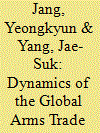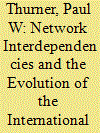| Srl | Item |
| 1 |
ID:
192056


|
|
|
|
|
| Summary/Abstract |
This study identifies security-related factors affecting the formation of the global arms trade network. This empirical analysis using a quantitative approach includes data from multiple sources (the Global Peace Index, Political Stability Index, Democracy Index, Global Terrorism Index, Fragile State Index, and military expenditure as a percentage of GDP) and multiple states analyzed using the ERGM. Arms trade data related to six attributes of states representing their (in)stability is collected and analyzed for 2012-2018. Our findings are as follows: (1) states with greater internal stability import more arms, which affects the formation of the global arms trade network; (2) states with greater external instability import more arms, which also affects the formation of the global arms trade network. This study makes two academic contributions, as follows. First, we analyze factors that form the global arms trade network from a holistic or systemic perspective. Second, we analyze those factors empirically and statistically from a security perspective.
|
|
|
|
|
|
|
|
|
|
|
|
|
|
|
|
| 2 |
ID:
167382


|
|
|
|
|
| Summary/Abstract |
Since few states are able to produce all of their own military hardware, a majority of countries’ military systems rely on weapon imports. The structure of the international defense technology exchange network remains an important puzzle to understand, along with the factors that drive its evolution. Drawing on a political economy model of arms supply, we propose a new network-oriented explanation for the worldwide transactions of major conventional weapons in the period after World War II. Using temporal exponential random graph models, our dynamic approach illustrates how network dependencies and the relative weighting of economic versus security considerations vary over time. One of our major results is to demonstrate how security considerations started regaining importance over economic ones after 2001. Additionally, our model exhibits strong out-of-sample predictive performance, with network dependencies contributing to model improvement especially after the Cold War.
|
|
|
|
|
|
|
|
|
|
|
|
|
|
|
|